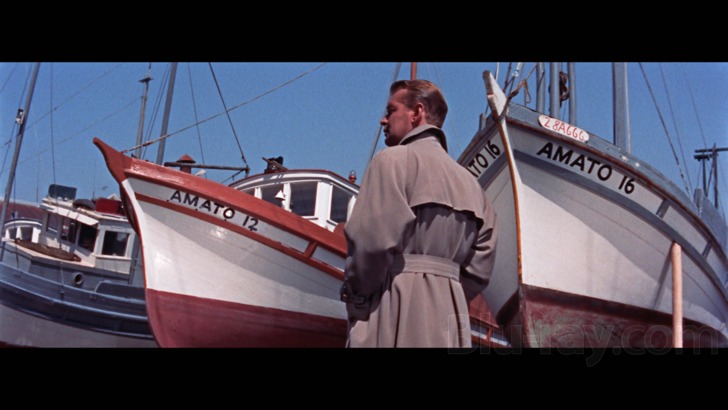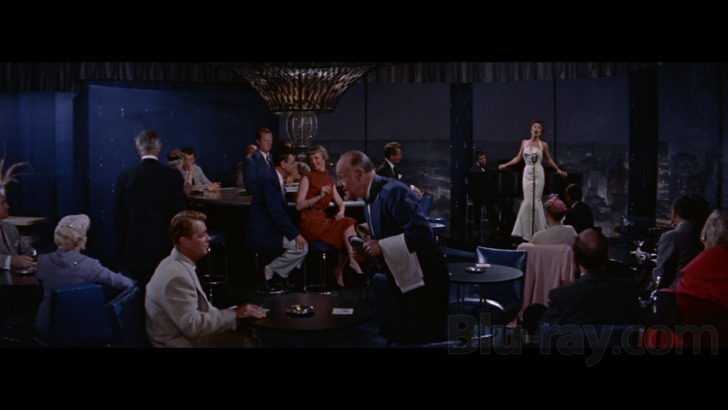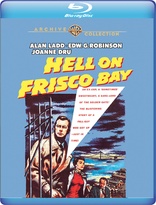Hell on Frisco Bay Blu-ray Movie
HomeHell on Frisco Bay Blu-ray Movie 
Warner Bros. | 1955 | 98 min | Not rated | Oct 24, 2017Movie rating
6.8 | / 10 |
Blu-ray rating
| Users | 4.0 | |
| Reviewer | 4.0 | |
| Overall | 4.0 |
Overview
Hell on Frisco Bay (1955)
After five years in prison, ex-cop Steve Rollins is paroled and begins his search for the San Francisco mobsters who framed him for manslaughter.
Starring: Alan Ladd, Edward G. Robinson, Joanne Dru, William Demarest, Perry LopezDirector: Frank Tuttle
| Film-Noir | Uncertain |
| Thriller | Uncertain |
| Crime | Uncertain |
| Drama | Uncertain |
Specifications
Video
Video codec: MPEG-4 AVC
Video resolution: 1080p
Aspect ratio: 2.55:1
Original aspect ratio: 2.55:1
Audio
English: DTS-HD Master Audio 2.0 Mono (48kHz, 24-bit)
Subtitles
English SDH
Discs
Blu-ray Disc
Single disc (1 BD)
Playback
Region A, B (C untested)
Review
Rating summary
| Movie | 3.0 | |
| Video | 4.5 | |
| Audio | 4.5 | |
| Extras | 0.5 | |
| Overall | 4.0 |
Hell on Frisco Bay Blu-ray Movie Review
The Irresistible Ladd Meets the Immovable Robinson
Reviewed by Michael Reuben November 1, 2017Hell on Frisco Bay was released in 1955, and while it was filmed in CinemaScope and
"Warnercolor", its spirit hearkens back to Warner Brothers' black-and-white gangster pictures of
the Thirties. The film was adapted from a novel by crime writer William P. McGivern, whose
work had already supplied the story for Fritz Lang's The
Big Heat and who would later co-author
the John Wayne cop adventure, Brannigan. McGivern's
novel was acquired by actor Alan Ladd's
production company as a vehicle for the Shane
star, and Ladd turned in one of his signature
laconic performances as a disgraced cop seeking revenge. But in an ironic turn, the film's leading
man and co-producer ended up being upstaged by his co-star, Edward G. Robinson, who added
yet another entry to his collection of memorable screen gangsters. Ladd hired director Frank
Tuttle, who had given the actor his breakthrough role as a hit man in This
Gun for Hire, and the
director chose to shoot major portions of the film on location in San Francisco, capturing a
grittier side of the Bay City than the dreamy landscape that Alfred Hitchcock would showcase a
few years later in Vertigo.
Frisco Bay hasn't been widely available in recent years, the victim of a complicated rights history
and a lack of acceptable elements for transfer to video. All of that should change with the Warner
Archive Collection's new Blu-ray, which is based on a 4K scan of the recently located camera
negative.

Former San Francisco cop Steve Rollins (Ladd) walks out of San Quentin after serving five years on a trumped-up conviction for killing a mob suspect. Rollins is met by his pal on the force, Dan Bianco (William Demarest), and his wife, Marcia Rollins (Joanne Dru, who played the rambunctious cavalry officer's niece in She Wore a Yellow Ribbon). Rollins promptly tells Marcia that he wants nothing to do with her. His excuse is an affair she had while he was inside, but as he later confesses to Bianco, his real reason is that he doesn't expect to live long. His only interest is avenging himself on the man he's sure is responsible for framing him: crime boss Victor Amato (Edward G. Robinson), who controls the city's waterfront and fishing industry and whose power has only grown in the years that Rollins has spent behind bars.
The first half of Frisco Bay focuses on Rollins' search for witnesses who can link Amato to the five-year-old crime, as the sullen ex-cop looks up old acquaintances, stands up to mob enforcers like Hammy (Stanley Adams) and gets chewed out and warned off by his former superior, Lt. Neville (played by familiar character actor Willis Bouchey, who specialized in gruffness). But as soon as Robinson's Amato appears, the film's center of gravity begins to shift in his direction, as Robinson tears zestfully into the role of a consummate bully, a perpetually angry and resentful brute to whom lording power over others comes as naturally as breathing. The most frequent object of the mobster's derision is his faithful lieutenant, Joe Lye (Paul Stewart, the butler in Citizen Kane), whom Amato never tires of reminding that he had to be "rescued" from death row and whose scarred face is a study in repressed suffering. Amato's delight in tormenting those around him knows no limits. Having reduced the entire world to two simple propositions—everything is for sale, and anyone can be killed—Amato seems determined to prove to all around him that this Hobbesian view is the one and only truth. As soon as mention is made of Joe's girlfriend, a retired actress named Kay Stanley (Fay Wray), it's obvious that Amato will eventually make a play for her, not because he's genuinely interested, but simply to prove that her love can be bought. (It can't.)
So thoroughly do Amato's machinations come to dominate Frisco Bay's narrative, and so intensely does Robinson bring this monster to life, that Rollins is relegated to the background for much of the film's latter half. Eventually, though, the two foes collide in the one-on-one face-off toward which the film has been inexorably heading. The runaway speed boat on which Tuttle stages their ultimate confrontation eerily anticipates the climactic battle between sworn enemies in John Woo's Face/Off, and Frisco Bay's extended action finale was so hazardous that a stunt man died filming it. By that point, Victor Amato's empire has crumbled around him, a victim as much of the crime boss's own misdeeds as of Steve Rollins' quest for revenge.
Hell on Frisco Bay Blu-ray Movie, Video Quality 

Hell on Frisco Bay was shot by John F. Seitz, the cinematographer of such visually inventive
films as Sunset Boulevard and Double Indemnity. According to the Warner
Archive Collection,
the film has not been seen in many years in its original CinemaScope aspect ratio, with only a
pan-and-scan master available for broadcast. The film has not been previously released on DVD,
let alone Blu-ray, due to a combination of tangled legal rights and the absence of acceptable
elements, all of which were several generations away from the original camera negative. With the
whereabouts of the OCN unknown, it was presumed to be lost or destroyed. Recently, however,
it was discovered in Warner's archives mismarked as "internegative", and an examination of the
element revealed that it was in excellent condition, a development made all the more surprising
by the fact that the film was a product of the short-lived process known as "Warnercolor", which
I have discussed elsewhere. With the OCN now in hand,
efforts to obtain the necessary
clearances for a home video release were renewed with a fresh urgency.
WAC's 1080p, AVC-encoded Blu-ray is the product of a 4K scan of the OCN, which was
performed by Warner's Motion Picture Imaging facility. Many hours of color correction
followed, performed by one of MPI's most senior and distinguished colorists. (As I noted in evaluating Night Moves, another 4K scan from negative, starting from the OCN entails
hours of additional labor; WAC estimates the expense at roughly four times that of a 2K scan from an interpositive.) After WAC's customarily
thorough cleanup to remove dirt and other imperfections, the image is one of
startling depth and clarity. The San Francisco location photography captures the city as it looked
in an earlier era, including Fisherman's Wharf when it still supported a thriving industry and
before it was rebuilt into a tourist attraction. The location footage has been neatly melded with
soundstage photography that is equally sharp and detailed, so much so that the scenes utilizing
rear projection stand out more obviously than they probably did for audiences in 1955.
The film's palette is modest and subdued in its location scenes, but intense blues and reds appear in specific
locations like the club where Marcia sings, and rich old-world earth tones dominate Victor
Amato's home and offices. MPI's color correction has massaged the frequent dissolves between
scenes to minimize the palette shifts that typically accompany that optically achieved effect; the
colors still shift, but lightly and briefly. The film's grain pattern has been naturally and finely
resolved, so much so that at times it almost disappears. The kinds of artifacts to which
CinemaScope lenses were prone (see discussion here)
are wholly absent, but that has less to do with the transfer to video than with director Frank Tuttle's limited use of camera pans.
Note, however, that the image retains the softness characteristic of CinemaScope lenses, and that
softness is magnified when the image is frozen for screen captures. The same phenomenon can
be seen in other CinemaScope/Warnercolor features from the same period, such as The Sea
Chase and Blood Alley. The
key difference between those Blu-rays and Frisco Bay is that the
latter has been derived from a 4K scan from negative instead of a 2K scan from an interpositive,
resulting in a finer and tighter grain structure. Some posters on internet forums, including this
site's, have incorrectly attributed these aspects of the disc's image to so-called "DNR", but
WAC does not use any form of digital noise reduction or other automated cleaning process. Its
masters are cleaned of dirt and defects by hand, one frame at a time. Nor does WAC apply any
high-frequency filtering of the sort that has been used by some studios in the past (including
Warner's main video division) to facilitate compression at low average bitrates. Frisco Bay has
been mastered at WAC's usual high average, here 34.98 Mbps.
Hell on Frisco Bay Blu-ray Movie, Audio Quality 

Hell on Frisco Bay was released in both mono and four-track stereo, and WAC was disappointed to discover that the only extant source for the stereo mix was so badly damaged that even the most sophisticated digital tools could not restore it. As a result, the Blu-ray has a mono track, taken from the magnetic master, cleaned of any age-related artifacts, and encoded as lossless DTS-HD MA. Even though the sound is mono, it's excellent mono, with broad dynamic range (for the period) and a lush reproduction of the orchestral score by the legendary Max Steiner (Casablanca and Gone with the Wind). The dialogue is clearly rendered, as are the essential sound effects.
Hell on Frisco Bay Blu-ray Movie, Special Features and Extras 

The sole extra is a trailer (1080p; 2.55:1; 2:12).
Hell on Frisco Bay Blu-ray Movie, Overall Score and Recommendation 

Hell on Frisco Bay was dismissed upon its initial release as just another gangster picture. Today,
when gangster films are even more their own genre than in the Fifties, this one stands out for the
focused intensity of its lead performances, which are ably backed by a deep bench of supporting
players. If we can't get more of Warner's classic gangster output from the Thirties, at least we
have this vivid rendition of Frisco Bay, which arrives with the novelty factor of providing the
film with its first widescreen presentation on home video. Highly recommended.
Similar titles
Similar titles you might also like

The Big Heat 4K
1953

Underworld U.S.A.
Limited Edition to 3000
1961

Angels with Dirty Faces
Warner Archive Collection
1938

Thieves' Highway
1949

The Killer Is Loose
Special Edition
1956

Impact
Collector's Edition
1949

Sudden Fear
1952

You Only Live Once
1937

711 Ocean Drive
1950

Heaven's Prisoners
1996

Key Largo
Warner Archive Collection
1948

Thunder Road
1958

Crime of Passion
1957

The Desperate Hours
1955

On Dangerous Ground
Warner Archive Collection
1951

Raw Deal
Reissue | Special Edition
1948

Dark Passage
Warner Archive Collection
1947

Straight Time
Warner Archive Collection
1978

Kiss Me Deadly
1955

Appointment with Crime
1946
